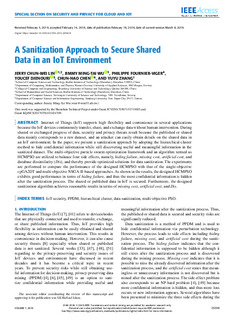A Sanitization Approach to Secure Shared Data in an IoT Environment
Lin, Chun Wei; Wu, Jimmy Ming-Tai; Fournier-Viger, Philippe; Djenouri, Youcef; Chen, Chun-Hao; Zhang, Yuyu
Journal article, Peer reviewed
Published version

Åpne
Permanent lenke
http://hdl.handle.net/11250/2599851Utgivelsesdato
2019Metadata
Vis full innførselSamlinger
Originalversjon
Lin, J. C.-W., Wu, J. M.-T., Fournier-Viger, P., Djenouri, Y., Chen, C.-H. & Zhang, Y. (2019). A Sanitization Approach to Secure Shared Data in an IoT Environment. IEEE Access, 7, 25359-25368. 10.1109/ACCESS.2019.2899831Sammendrag
Internet of Things (IoT) supports high flexibility and convenience in several applications because the IoT devices continuously transfer, share, and exchange data without human intervention. During shared or exchanged progress of data, security and privacy threats result because the published or shared data mainly corresponds to a raw dataset, and an attacker can easily obtain details on the shared data in an IoT environment. In the paper, we present a sanitization approach by adopting the hierarchical-cluster method to hide confidential information while still discovering useful and meaningful information in the sanitized dataset. The multi-objective particle swarm optimization framework and an algorithm termed as HCMPSO are utilized to balance four side effects, namely, hiding failure, missing cost, artificial cost, and database dissimilarity (Dis), and thereby provide optimized solutions for data sanitization. The experiments are performed to compare the performance of the designed HCMPSO with that of the single-objective cpGA2DT and multi-objective NSGA-II-based approaches. As shown in the results, the designed HCMPSO exhibits good performance in terms of hiding failure, and thus the most confidential information is hidden after the sanitization process. The shared or published data in IoT is secured. Furthermore, the designed sanitization algorithm achieves reasonable results in terms of missing cost, artificial cost, and Dis.